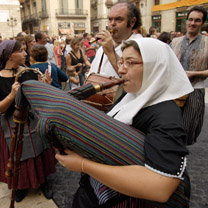Cornamusa
Imatge destacada

The cornamusa or sac de gemecs is a bagpipe-like instrument from the aerophone family of instruments, comprising a small leather bag which serves as an air sac. This bag has three holes which are open to different pipes: the smallest, known as the tudell, is the blowpipe for blowing in air with the mouth; the next is the grall, or chanter, which has a series of holes allowing you to play the melody; and exiting from the third hole, the bordó, is a variable number of drone pipes.
The origin of the cornamusa is uncertain, but everything points to it being from Roman times. In fact, different variations can be found all over Europe. In the Catalan-speaking lands, it has a long and deeply rooted tradition going back to the 12th century. The various forms of this instrument are known as the sac de gemecs in Catalonia, buna in Andorra, coixinera in Valencia and xeremia in the Balearic Islands.
These days the instrument is not widely used, but it has been well preserved in Majorca, where it plays a key role in traditional music. Here, street groups made up of a xeremia, a tiny tamborí drum and a flabiol flute can be seen in all kinds of popular festivals. Outside Majorca, the cornamusa is only played to accompany other instruments, in groups like the mitja cobla, the cobla de tres quartans and the cobla de ministrers.



